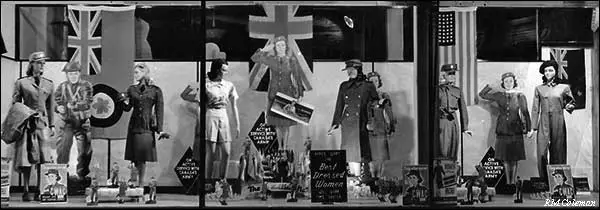 October 2022
October 2022
Women in Military Service. Agnes Wilkie joined the Royal Canadian Naval Medical Service during WWII when, for the first time, women were being enlisted for service in the Canadian Armed Forces. They could now serve in the army, air force or navy and in the nursing services associated with each military branch. The intent was to have women perform traditional female work such as cooking, laundry or clerical duties so the men who traditionally did those jobs could be freed for combat. Some female recruits also served in areas such as recruitment or communications, others as drivers or mechanics. They are viewed as pioneers for full equality of women in both leadership and combat roles in our present-day military services. See also the Canadian Encyclopedia.
Display of uniforms, aimed at recruiting women during WWII [Photo: W.A. Leary]
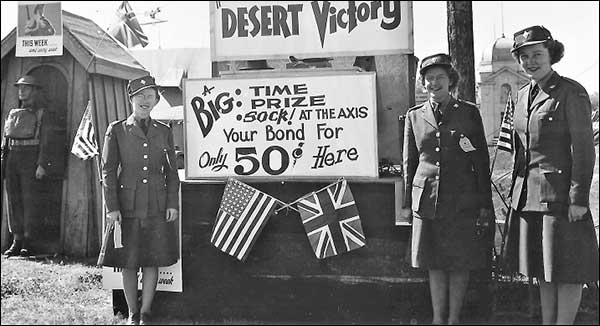
CWAC personnel from Mobile Recruiting Unit recruiting at fair WWII [Photo: W.A. Leary]
Although women’s service in the Canadian military officially began during WWII, the wartime role of nursing sisters, such as Agnes Wilkie, began much earlier. Nursing, as a profession, had its origin in Florence Nightingale’s service in the Crimean War and her subsequent establishment of training schools for nurses. In Canada, Nursing was an official part of military operations long before WWII. In an informative article published in the Canadian Encyclopedia, author Nancy Miller Chenier outlines how Canadian Nursing Sisters “carried out official duties with the military during the North-West Resistance, the South African War, the First and Second World Wars, and the Korean War. She points out that at least 70 nursing sisters died from enemy action and disease during their service.” See also the Canadian Encyclopedia.
This overview of the broader context of military nursing serves as a reminder that Agnes Wightman Wilkie is part of a long history of nursing service during times of war. Perhaps, by extension, it also should remind us of the front-line service of nurses and other health care providers who are ‘battling’ the current pandemic.
November 2018
Nursing Sisters. One aspect of military service that is often overlooked is the service of Nursing Sisters with the Canadian Army Medical Corps. Anna and Grace Bruce were two local sisters who served with distinction in WWI. Their parents were early settlers in the Stephenfield district. The sisters both trained in Vancouver General Hospital. Anna received the prestigious Royal Red Cross for bravery while serving in Greece. She also was awarded the Order of the British Empire (O.B.E.) in 1920. Grace served in England and France; among the patients she nursed was John McCrae, author of ‘In Flanders Fields’.
Their brother George also was a decorated WWI soldier. Read more about the family in “The History of the R.M. of Dufferin 1880–1980, p.358. The photograph of the three siblings is of interest—the caption notes that Anna and Grace could not pose in their uniforms because they were lieutenants and outranked their military brother.
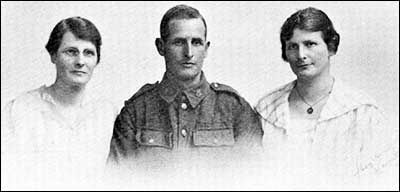
Anna, George & Grace Bruce WWI
November 2018
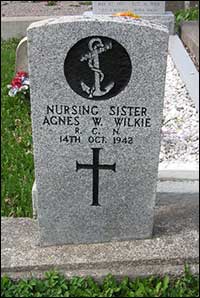
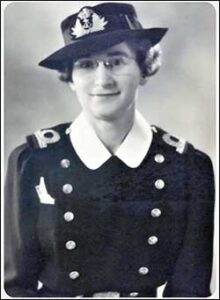
Agnes Wrightman Wilkie, a WWII Nursing Sister with local connections, has been in the news this Remembrance Day. Agnes’ grandparents homesteaded on SW 6-7-7w near Roseisle in 1887. Agnes graduated from high school in Carman then completed her Nursing program with distinction at Misericordia General Hospital.
She joined the Royal Canadian Navy as a Nursing Sister. She died when the S.S. Caribou on which she was returning to duty in St. John’s, Newfoundland after visiting her parents in Carman was struck by an enemy torpedo in the Gulf of St. Lawrence. Agnes was the only Nursing Sister killed by enemy action in WWII. She was buried with full military honours.
Read more about her bravery and compassion and the many ways in which she has been honoured in Newfoundland, Carman and at Misericordia Hospital in a Facebook article by Dr. Barbara Paterson, chair of the MGH heritage collection.
